
 Copyright © Michael Richmond.
This work is licensed under a Creative Commons License.
Copyright © Michael Richmond.
This work is licensed under a Creative Commons License.
There are a number of phenomena in astronomy which give rise to periodic signals:
If you suspect that your target is varying in a regular way, how can you find its period? Today, I'll describe several aspects of this common problem. We'll start by looking at small sets of measurements coverting just a few crucial portions of the period, then graduate to methods which deal with longer stretches of data.
Suppose we are interested in a star which clearly varies in a regular manner; one example is called ASAS 002511.

One very simple way to measure the period of this star is to determine the time of two adjacent minima. Let's zoom in on one section of the data:
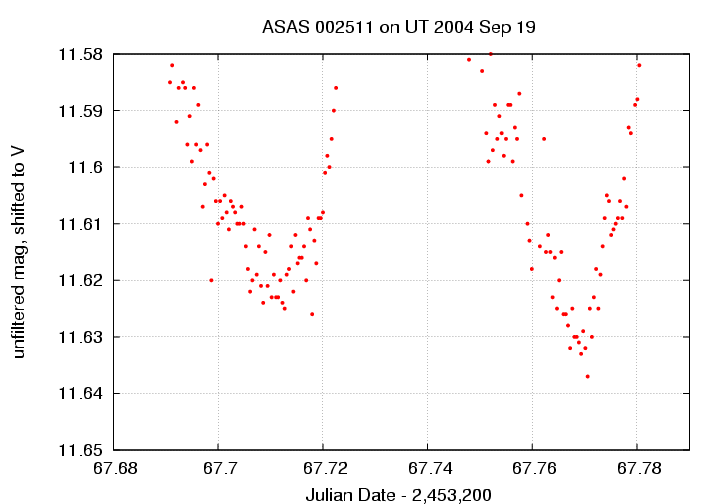
At what time does each minimum occur? Hmmmm. How could we measure it?
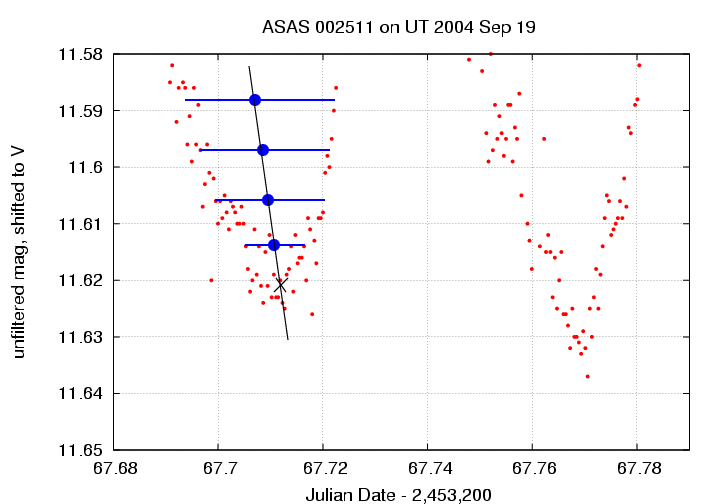
Exercise:
- What is the time of the first minimum in this closeup?
- What is the time of the second minimum in this closeup?
- What is the period based on these two minima?
How accurate is this period, based on measurements over just one cycle? Well, let's find out: we'll predict the time of an event in the future.
Exercise:
- Start with the time of the minimum shown at right in the closeup above. Using your period, predict when exactly 16 (sixteen) more cycles should have just finished, so that the light curve is at a minimum again.
- Look at the figure below, which shows measurements of the star on the following night. At what time does the sixteenth cycle actually finish?
- Use this time to improve your estimate of the period.

The great thing about truly periodic signals is that one can improve one's estimate of the period by watching for a long time and counting many cycles. The planet Saturn, for example, has been observed and measured accurately by humans for hundreds of years. The JPL Horizons system has this value for its period:
Saturn: Sidereal orbit period = 29.447498 yr
In practice, one may lack continuous coverage of a star over several consecutive cycles. For example, consider a student plagued with bad weather, who can make just one measurement each night -- and only on some nights.
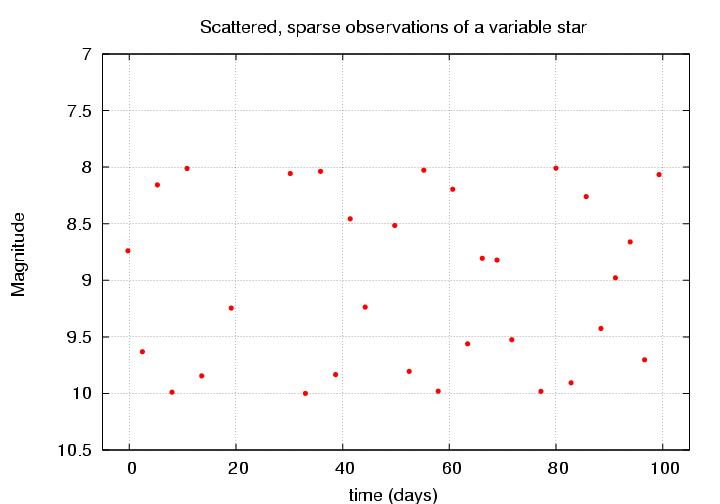
Don't despair -- it is still possible to determine the period of this star. We just have to use other methods ...
Consider a very simple periodic signal:
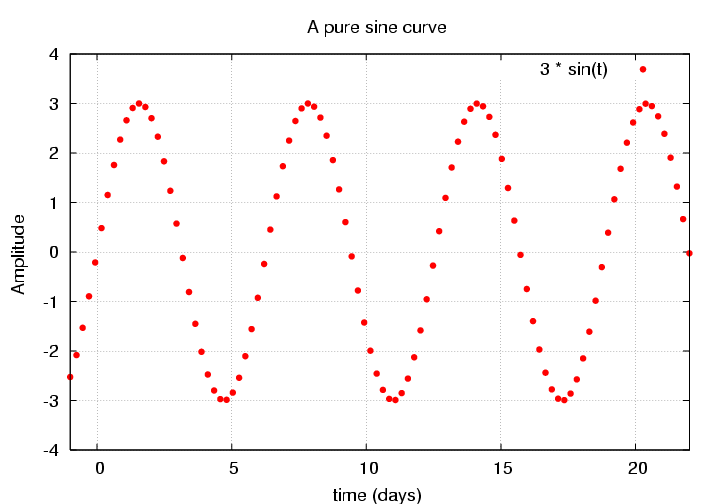
A sine wave described by
y = 3 * sin( x )
We can describe this signal with two parameters:
If we have a very long stretch of data, and we plot the signal versus time, we end up with a very long graph:
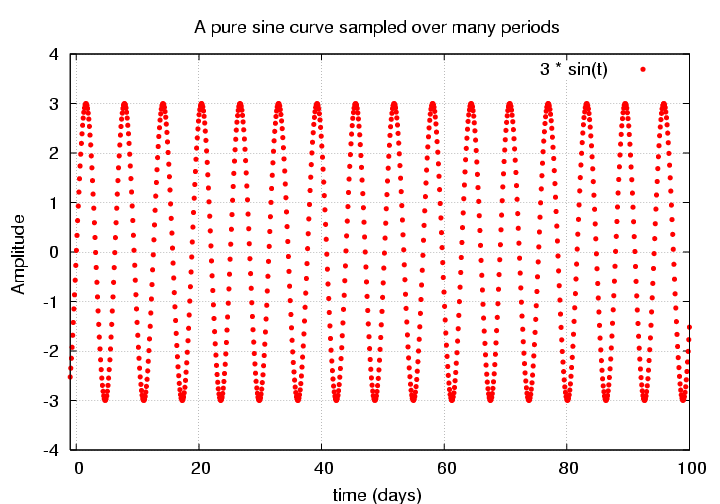
It is possible to squish a very long stretch of data onto a small graph if one converts the time variable to a related quantity: phase. Phase is defined as the fractional portion of the number of periods which have elapsed at a given time:
t
phase at time t = fractional portion of ( --------- )
period
t t
= -------- - int ( ---------- )
period period
The phase ranges over a fixed, small range: from 0.0 (start of a period) to 1.0 (end of a period). If we take that same sine curve as before, with data running from time t=0 days to t=100 days, and this time plot its value versus phase, we get a very simple graph:
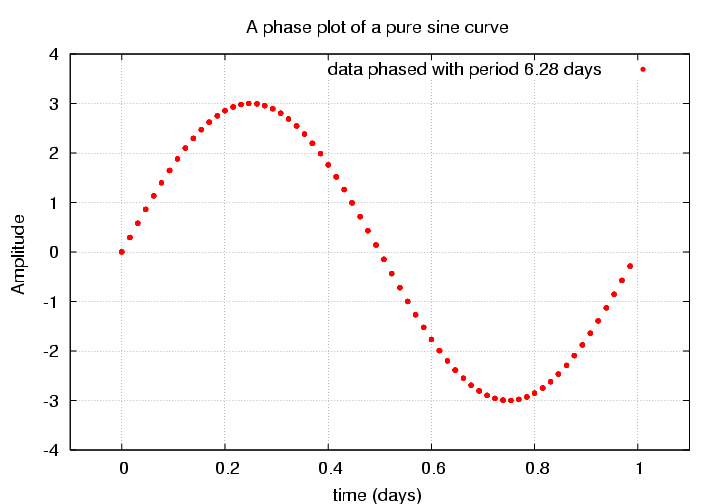
This has nice features:
As you will see below, we can use phase diagrams to figure out the period of an unknown signal.
What happens if we try to calculate the phase of a signal, but do so with the wrong period? Once again, we'll use a simple sine curve to illustrate. But this time, we'll calculate the phase with a period slightly different from the true value. Instead of a period of 6.28 days, we'll use a period which is just 2 percent larger: 6.41 days. When we plot the points in a phase diagram, we see this:
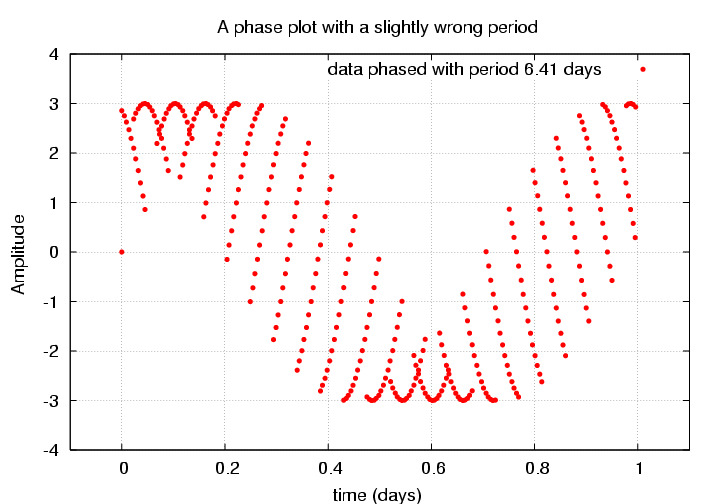
Hey! The phased data no longer lie along a single, smooth locus in the diagram. Instead, they form a wide band. This is a signal that the period used to calculate the phase was incorrect.
If we use a period which is far from the true value, the phased data scatter all over the diagram:
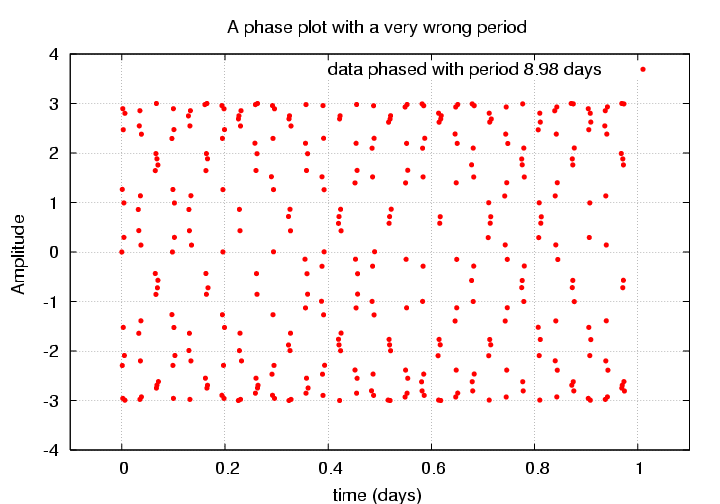
Only if the proper period is used to calculate the phase will the data fall along a single, narrow path in the phase diagram. We can use this fact to determine the period: pick a period, calculate the phase, and plot the resulting phase diagram. Modify the period and repeat until the points fall along a narrow locus.
Let's try that method with the sparse measurements mentioned earlier. Here they are again, in graphical form ...

and in tabular form, like this:
day mag
2.458 , 9.631
5.280 , 8.157
8.003 , 9.989
Can you find the period?
Exercise:
- Use a spreadsheet program to create a new column of numbers, based on the "day" column.
- Guess an initial period, in days, and then compute for each measurement
phase = (day / period) - INT(day / period)Then plot the "mag" column versus the "phase" column. How does your phased light curve look?
- Modify your initial guess at the period and replot the light curve. Can you find a period which yields a smooth, continuous light curve?
The method does work, but it sounds pretty subjective; is there any way to make it quantitative? Yes! The string-length method provides a numeric metric for assessing the "narrowness" of the locus of points in a phase diagram. A good reference is the paper "A period-finding method for sparse randomly spaced observations of 'How long is a piece of string?' " by Mike Dworetsky, MNRAS, 203, 917 (1983); you can find it on-line at the NASA ADS Abstract Service
The idea is simple:
LOOP:
The period which yields the smallest sum of lengths ("shortest piece of string") is the best estimate of the true period.
Give it a try! Here are some measurements of a variable star on several nights during the course of week:
Time (truncated Julian Date) Magnitude
---------------------------- -----------
12.46 8.417
12.55 8.500
12.64 8.835
12.73 9.167
12.79 9.261
13.45 9.267
13.54 9.078
13.63 8.707
13.69 8.499
15.52 8.836
15.61 8.503
15.70 8.415
15.79 8.632
17.68 8.530
17.77 8.880
A light curve of the star looks like this:
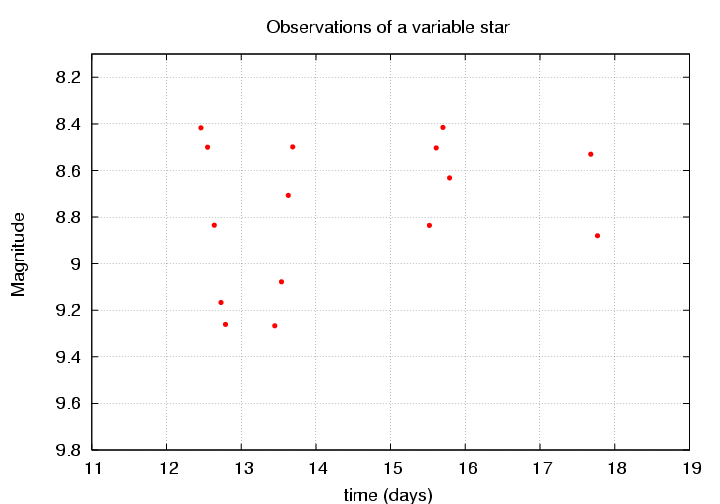
Make a guess at a reasonable range for the period -- it's some fraction of a day. Then, divide the interval into a number of pieces, and for each candidate period, make a phase diagram and calculate the string length. It takes time ... but one can easily program a computer to perform the calculations.
Periodic signals aren't restricted to stars: they are all over the place, in physics, mathematics, geology, communications, you name it. Over the centuries, people have devised LOTS of methods to deal with periodic signals. I can't possibly do justice to the entire field in this space, but I can mention a very few techniques that I've seen in the astronomical literature.
Repeat for a set of possible periods. Pick the period which yields the smallest sum of residuals.
Jeff Robertson of Indiana University gave a very nice list of references for period-finding techniques in an E-mail to VSNET (vsnet-chat 131), which I reproduce below:
-----------------
An old but nice introduction and review to the four or five most popular period
finding methods can be found in [1] by Fullerton. This includes the various
"string-length" methods made popular by Lafler and Kinman [2]. This method has
been expanded upon by Stellingwerf [3] with the PDM method which is now a part
of IRAF. Most of the people I am associated with use FFT methods as prescibed
by Horne and Baliunas [4] and can now be found in the Numerical Recipes [5]
book. There is also a DFT method [6] which I am not to familiar with.
I am also interested in anyone else's methods and ideas...
References:
1. The Study of Variable Stars Using Small Telescopes, Fullerton, A.W. 1986,
ed. J.R. Percy, Cambridge University Press, p 201-218.
(This book can be found in the University of Rochester library system)
2. An RR Lyrae Survey With The Lick 20-inch Astrograph II. The Calculation
An RR Lyrae Survey With The Lick 20-inch Astrograph II. The Calculation
of RR Lyrae Periods By Electronic Computer, Lafler, J. and Kinman, T.D.
ApJS 11, p 216-222.
3. Period Determination Using Phase Dispersion Minimization (PDM),
Stellingwerf, R.F. 1978, ApJ 224, 953-960.
4. A Prescription for Period Analysis of Unevenly Sampled Time Series,
Horne, J. and Baliunas, S. 1986, ApJ 302, 757-763.
5. Search Algorithm For Weak Periodic Signals In Unevenly Spaced Time-Series,
Press, W.H. and Teukolsky, S.A., Numerical Recipes, Cambridge Univ. Press.
6. Time Series Analysis with Clean - Part One - Derivation of a Spectrum,
Roberts, D. H., Lehar, J., Dreher, J. W.,
1987, AJ, 93, 968.
which is illustrated in practice here ...
Discovery of a possible X-ray triple - 4U 1915-05,
Grindlay, J. E., Bailyn, C. D., Cohn, H., Lugger, P. M., Thorstensen, J. R.,
Wegner, G., 1988, ApJ, 34L, 25
-------------------
You can find some tools to analyze stellar light curves on-line.
The star used as an example near the start of this lecture, ASAS 002511, is a cataclysmic variable.
 Copyright © Michael Richmond.
This work is licensed under a Creative Commons License.
Copyright © Michael Richmond.
This work is licensed under a Creative Commons License.